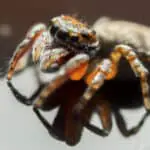Cats are known for their mysteriousness, captivating us with their unique features and stunning eyes. One particularly fascinating aspect of feline eye color is the occurrence of heterochromia, a condition in which a cat has two differently colored eyes. This natural phenomenon can leave many wondering about the reasons behind such a striking feature in our feline companions.

The development of eye color in cats starts at a young age and involves the pigment melanin. Typically, kittens are born with blue eyes, and over the following weeks, melanin moves into the iris, causing their eyes to change to green, yellow, or brown. In the case of an odd-eyed cat, however, the melanin is only present in one eye, leaving the other to remain blue. Factors such as genetics could play a role in the unusual pigmentation distribution that results in heterochromia.
Aside from complete heterochromia, where both eyes have entirely distinct colors, cats may also display sectoral heterochromia, a condition where a single iris contains two or more colors. This intriguing variation, also caused by an inconsistent distribution of pigment within the iris, adds to the wide array of eye colors and patterns seen in the feline world.
The Science of Cat Eye Colors
Genetic Influence on Eye Color
Cats have different eye colors due to the influence of genetics. The color of a cat’s eyes is determined by the combination of various genes, which control the production and distribution of melanin, the pigment responsible for color in the iris. The amount and type of melanin produced can result in a range of eye colors, including blue, green, brown, and yellow.
Roles of Melanin and Pigment
Melanin plays a crucial role in determining a cat’s eye color. The iris of a cat’s eye contains special cells called melanocytes, which produce melanin. There are two types of melanin found in the iris:
- Eumelanin: This pigment is responsible for creating black, brown, and dark yellow colors.
- Pheomelanin: This pigment provides lighter, reddish-yellow and orange colors.
When a cat has no melanin in the iris, its eyes appear blue due to the reflection and scattering of light. The amount and combination of melanin produced by melanocytes influence the final color of a cat’s eyes.
Common Eye Colors in Cats
Here are some prevalent cat eye colors along with brief explanations:
- Blue eyes: Cats with blue eyes have no melanin in their irises. The blue color is a result of light reflection and scattering.
- Green eyes: Green eyes in cats are often a result of low amounts of both eumelanin and pheomelanin pigments.
- Brown eyes: Brown eyes in cats have a high concentration of eumelanin, giving them a darker color.
- Yellow eyes: Yellow eyes in cats typically have lower levels of eumelanin and higher concentrations of pheomelanin.
In some cases, cats exhibit an eye condition called heterochromia, where each eye has a different color. This can occur due to a genetic mutation that interferes with melanocyte activity in one eye, leading to one blue eye and another eye that is green, yellow, or orange.
Heterochromia in Cats
Different Types of Heterochromia
Heterochromia, also known as “odd-eyed” in cats, refers to the condition where a cat has eyes with two different colors. This intriguing trait can typically be classified into two main types:
- Complete heterochromia: Also referred to as “heterochromia irides,” this is when a cat has two entirely different colored eyes, such as one blue eye and one green eye. This is the most common form of heterochromia in cats.
- Sectoral heterochromia: This form of heterochromia, sometimes called partial heterochromia, occurs when a cat’s eye contains two or more colors within the same iris. For example, one section of the iris may be blue, while the rest is green.
Genetic and Health Factors of Heterochromia
The primary cause of heterochromia in cats can be traced back to the melanin distribution within the iris. Melanin is a pigment responsible for eye color in cats, and during a kitten’s development, the melanin cells move into the iris changing eye color to green, yellow, or brown. Odd-eyed cats only undergo this process in one eye, leaving the other blue.
The genetic component of heterochromia is closely linked to the dominant white gene or the white spotting gene, which also determines a cat’s coat color. Cats with a white coat are more likely to exhibit heterochromia due to the gene responsible for both eye color and fur color.
While heterochromia might not always be linked to health problems, it’s essential to be aware of some potential risks. For instance:
- Inflammation: A cat with heterochromia may be more susceptible to inflammation, particularly uveitis – an inflammation of the middle layer of the eye.
- Deafness: In some cases, odd-eyed white cats can have a higher chance of being deaf, especially when the deafness is associated with the blue-eyed side.
In conclusion, heterochromia in cats is a fascinating trait often linked to genetics, specifically the white coat gene. While it can be visually stunning, cat owners should be mindful of potential health issues, such as inflammation and deafness, to ensure their feline friend’s wellbeing.
Breeds and Specific Eye Colors
Breeds Prone to Unique Eye Colors
Some breeds of cats are more likely to have unique eye colors than others. For example, Turkish Angora and Turkish Van cats often exhibit odd-eyed phenomenon, where they have two different colored eyes. Japanese Bobtails are another breed with a higher incidence of this trait. Siamese cats are famous for their striking blue eyes, which are due to a gene that affects pigment development in both their fur and their eyes.
In rarer breeds like the Khao Manee and Sphynx, unusual eye colors, including blue, amber, and odd-eyed combinations, are more common. Persian cats often have copper or golden eyes. The British Shorthair is known for vibrant copper or orange eyes, which contrast with their soft, blue-grey coats.
Influence of Coat Color vs Eye Colors
Coat color can influence a cat’s eye color, mainly due to the impact of specific genes. Here is a brief overview of some coat and eye color relationships in cats:
- White cats: They can have blue, yellow, green, or odd-eyed combinations. A lack of pigment in white cats can result in blue eyes or heterochromia.
- Siamese cats: Their blue eyes are linked to the points pattern on their coat, which is controlled by the same gene responsible for their eyes’ color.
- Solid or Bicolor cats: Cats with solid or bicolor coats, such as the British Shorthair, usually have a range of eye colors, including copper, gold, green, and hazel, with some individual variations.
While some breeds have characteristic eye colors, this is not the case for all cats. Sometimes, the eye color can be unpredictable and unique, making each cat a beautiful and fascinating individual.
Caring for Cats with Different Eye Colors
Taking care of a cat with different eye colors, also known as heterochromia, requires just as much attention and affection as any other cat. In this section, we will discuss some special considerations for these unique felines, including regular veterinary check-ups and monitoring for health conditions.
Regular Veterinary Check-ups
It is important to schedule regular veterinary check-ups for your cat, regardless of its eye colors. This is because domestic cats, including purebred and mixed breeds with heterochromia, also need routine care for their overall health and well-being. During these visits, the veterinarian will examine your cat’s eyes and look for any potential issues or concerns related to vision and eye health.
- Schedule annual or bi-annual visits depending on your cat’s age and health status.
- Always consult with your veterinarian about any changes in your cat’s behavior or appearance, including its eyes.
Monitoring for Health Conditions
While heterochromia in cats is not typically associated with health problems, some cats with different eye colors may be more prone to certain conditions related to vision or hearing. As a caring cat owner, you should be vigilant and monitor your cat for any signs of potential issues. Here are some tips to keep in mind:
- Observe your cat’s behavior: Pay special attention to their movements and interactions with their surroundings. This will help you identify any changes in their vision or hearing abilities.
- Check their eyes: Regularly examine your cat’s eyes for any signs of irritation, redness, or discharge. If you notice anything unusual, consult with your veterinarian.
- Protect their vision: Ensure that your cat’s living space is well-lit, safe, and free from any hazards that could cause injuries or vision problems.
- Understand the breed-specific risks: Some purebred cats with heterochromia may be more susceptible to certain health conditions. It is essential to educate yourself about these risks and follow the recommendations provided by your veterinarian.
By providing your cat with regular veterinary check-ups and monitoring for health conditions, you’ll ensure that your unique, different-eyed feline friend enjoys a happy and healthy life.








